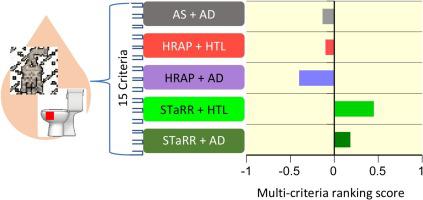Journal of Water Process Engineering ( IF 7 ) Pub Date : 2020-06-30 , DOI: 10.1016/j.jwpe.2020.101485 Srimali P. Munasinghe-Arachchige , Isuru S.A. Abeysiriwardana-Arachchige , Himali M.K. Delanka-Pedige , Nagamany Nirmalakhandan

|
In assessing sewage treatment systems, decision makers now have to consider sustainability, affordability, and reliability beyond functionality. To facilitate this complex assessment, multi-criteria decision making (MCDM) tools have evolved recently. This case study illustrates an application of the Preference Ranking Organization METHod for Enrichment of Evaluations (PROMETHEE) method in the MCDM process in evaluating five sewage treatment systems: activated sludge treatment followed by anaerobic digestion (P1); photoautotrophic algal treatment followed by hydrothermal liquefaction (P2) or by anaerobic digestion (P3); and, mixotrophic algal treatment followed by hydrothermal liquefaction (P4) or by anaerobic digestion (P5). This evaluation is based on 15 criteria aligned with the United Nation’s sustainable development goals. Based on energy recovery, the five processes ranked as follows: P2; P3; P4; P5; and P1. But, when all the 15 criteria are considered, P4 ranked as the most preferred option followed by P5 and P2. Utility of the MCDM approach in highlighting drawbacks of the options and identifying areas for improvement is illustrated. This study indicated that recovering phosphates and energy from the digested sludge in P1 offer greater potential to improve its ranking than by minimizing its energy demand for aeration. Increasing biomass density in the mixotrophic system can further improve its ranking, minimizing footprint and maximizing recoveries. Since the energy-intensity of hydrothermal liquefaction in P2 and P4 (4.57 and 23.23 kWh/kg BOD, respectively) is higher than that of anaerobic digestion in P1 (0.01 kWh/kg BOD), nutrient recovery from its byproducts has to be maximized to justify its selection.
中文翻译:

使用多准则决策方法对污水处理工艺进行优化和强化:案例研究
在评估污水处理系统时,决策者现在必须考虑功能之外的可持续性,可负担性和可靠性。为了促进这种复杂的评估,最近开发了多标准决策(MCDM)工具。本案例研究说明了MCDM流程中优先选择评估方法提高评价等级方法(PROMETHEE)在评估五个污水处理系统中的应用:活性污泥处理后厌氧消化(P1);光合自养藻类处理,然后进行水热液化(P2)或厌氧消化(P3);混合营养藻类处理,然后进行水热液化(P4)或厌氧消化(P5)。该评估基于与联合国的可持续发展目标一致的15条标准。基于能量回收,五个过程的排名如下:P2;P3; P4; P5; 和P1。但是,当考虑所有15条标准时,P4排在最优先选择的位置,其次是P5和P2。说明了MCDM方法在突出选项的缺点和确定需要改进的地方方面的效用。这项研究表明,从P1中消化的污泥中回收磷酸盐和能量比通过最小化曝气的能量需求提供了更大的潜力来提高其排名。混合营养系统中生物量密度的增加可以进一步提高其排名,最大限度地减少占地面积并最大程度地提高回收率。由于P2和P4的水热液化的能量强度(分别为4.57和23.23 kWh / kg BOD)高于P1的厌氧消化的能量强度(0.01 kWh / kg BOD),



























 京公网安备 11010802027423号
京公网安备 11010802027423号